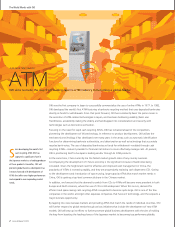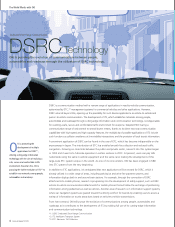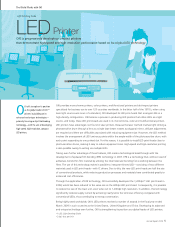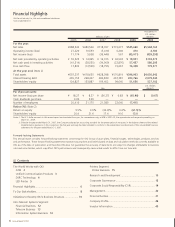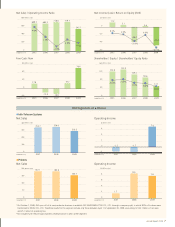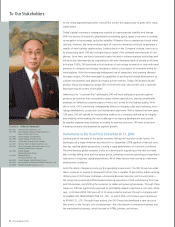Oki 2009 Annual Report Download - page 7
Download and view the complete annual report
Please find page 7 of the 2009 Oki annual report below. You can navigate through the pages in the report by either clicking on the pages listed below, or by using the keyword search tool below to find specific information within the annual report.
Annual Report 2009 5
The World Works with OKI
LEDPrinter
OKI is progressively developing compact printers
that demonstrate high-speed and high-resolution performance based on its original LED technology.
Light Emitting Diode
OKI will strengthen its position
as the global leader of LED*1
printers by building on its
advanced and unique technologies—
primarily focusing on Epi Film Bonding
technology—with the aim of developing
high-speed, high-resolution, compact
LED printers.
OKI provides monochrome printers, color printers, multifunctional printers and dot-impact printers
specialized for business use to over 120 countries worldwide. In the latter half of the 1970’s, when using
laser light sources was more of a standard, OKI developed its LED print-heads that arranges LEDs in a
high-density configuration. OKI became a pioneer in producing LED printers that utilize LEDs as a light
source, and today, these LED print-heads are used in its monochrome, color and multifunctional printers.
LED printers have advantages not found in laser printers. Because the laser method involves light striking a
photosensitive drum through a lens as a single laser beam rotates a polygonal mirror, delicate adjustments
are required and there are difficulties associated with reducing equipment size. However, the LED method
involves the arrangement of LED luminous points within the ample width of the photosensitive drum, with
each point responding to one printed dot. For this reason, it is possible to install LED print-heads close to
photo-sensitive drums, making it easy to reduce equipment sizes. High-speed and high-resolution printing
is also possible owing to writing via multiple LEDs.
Taking even further advantage of these features, OKI made a technological breakthrough with the
development of epitaxial film bonding (EFB) technology in 2007. EFB is a technology that, without need of
adhesives, bonds thin film material by utilizing the intermolecular bonding force working between the
films. The use of this technology makes it possible to integrate thinned LED—consisting of two different
materials used in LED print-heads—with IC drivers. Due to this, the new LED print-heads are half the size
of conventional products, while reducing production processes and materials have contributed greatly to
enhanced cost efficiencies.
Through the application of EFB technology, OKI successfully developed the 1,200dpi*2LED print-head in
2008, which has been reduced to the same size as the 600dpi LED print-head. Consequently, it is possible
to reduce the size of the main unit, even when set to 1,200dpi high resolution. In addition, this technology
significantly reduces supply current by achieving nearly twice the luminous efficiency compared with
conventional LEDs, thus contributing to energy conservation.
Being highly rated worldwide, OKI’s LED printers received a number of awards in the fiscal year ended
March 2009 in such countries as the United States, United Kingdom and China. Developing its advanced
and unique technology even further, OKI is strengthening its position as a global leader of LED printers.
*1 LED: Light Emitting Diode
*2 dpi: dots per inch




